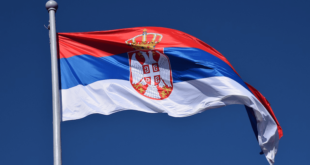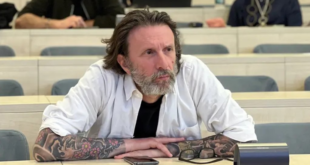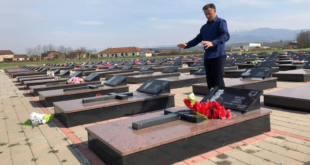Mirroring the demographic decline of the entire country, a massive and still-deepening population drop in the last 30 years will likely see Glamoc, a picturesque town in Bosnia and Herzegovina, empty completely.
Squeezed between pastures and hills, and circled by green belts of forest, Glamoc sits in a lonesome mountainous area in southwestern Bosnia and Herzegovina, some 200 kilometres from the Bosnian capital of Sarajevo. Reachable via winding mountain roads, very rutted in some spots and every so often crossed by free-roaming wild horses, the town consists of one hotel, two schools, three churches, a football field, an almost-ruined hospital and perhaps more coffee bars than grocery stores, striking evidence of Bosnia’s ritual passion for coffee.
Only one element is visibly missing: people.
It’s even more conspicuous in the evenings, when the streets are deserted, the lights in many windows are off and Glamoc’s sole late night bar Exit empties out long before midnight.
With a population decline of more than 75 per cent in the last three decades, Glamoc is one of Bosnia’s hardest-hit places by the demographic crisis. Between 1991 and 2022, this picturesque town with a current population of roughly 1,000 has lost almost 3,500 of its residents, while the whole of Glamoc municipality – part of the Federation of Bosnia and Herzegovina, where the majority of Croats and Bosniaks live – lost more than 10,000.
As the locals interviewed by BIRN fear, with no political strategy nor any new economic incentives, this trend will only continue, contributing further to the depopulation of the entire country, which, according to Bosnia’s statistical office, could lose more than half of its citizens over the next 50 years.
Left forever
Just in the decade from 2010, around 400,000 people left Bosnia, while the country’s fertility rate of just 1.3 is in the top-ten lowest rates in the world, according to the World Bank. This combination of the collapse in the number of children being born and large-scale emigration makes the country’s further depopulation “unstoppable”, believes Drasko Marinkovic, a professor in demography at the University of Banja Luka.
The third factor is perhaps political impotence, a result of the highly decentralised political system introduced by the 1995 Dayton Peace Accords that ended Bosnia’s war, which was based on the sensitive principle of the balance and equality of Bosniaks, Serbs and Croats. Over the ensuing years, “no common and comprehensive strategy that would directly relate to the issue of demographic development has been put together,” admits Marinkovic.
To make the situation darker, he adds, nowadays it’s not the low-skilled male labour force that is primarily leaving the country, like some 20 years ago, but qualified and well-educated men and women.
Here, in Glamoc, youngsters, after graduating from a local elementary or high school, usually leave for good to Banja Luka, Mostar, Sarajevo, Split or Zagreb, among other popular directions, either to find a job or to get into university. Many start families elsewhere, returning just for the holidays.
This is the pattern that Blagoja Soldat hopes his 11-year-old daughter and eight-year-old son will follow too. “I don’t want them to stay in Glamoc,” says Soldat, 41, head of the Pucka kuhinja (“Public kitchen”), a humanitarian program providing meals for locals, and chairman of the Glamoc branch of the Croatian Democratic Union party.
Glamoc, he explains sitting in the Pizzeria Relax, is, in many ways, a microcosm of all the problems troubling Bosnia – a country where the people have been let down by a dearth of economic opportunities, neglected infrastructure and weak public services, poor air quality, corruption, and little hope the future will bring any substantive change.
Nikola Radanovic, a 33-year-old graduate of law at the University of Banja Luka, who, against all odds, came back to his hometown in December 2020, is a rare example.
His return came after years of looking for fresh starts elsewhere and many disappointments in between. For instance, while working in the private sector, he says to have witnessed “how people are treated differently under the law and how the laws are being amended to satisfy concrete groups.”
Now, with a job at a local public administration and girlfriend living in the next-door village, Radanovic seeks to leave that past behind and build in Glamoc a quiet life. It’s here, among lush nature, where he has found a quality closest to his heart: stability.
“I’m not saying I don’t have bigger ambitions,” he says. “But, for now, I feel good here. This is my place on earth.”
In the olden days
Today half-deserted, Glamoc was once a vibrant place utilising its natural resources, including a mountainous location near the lake and just one hour and a half away from the Croatian coast of the Adriatic Sea. The lake especially became a magnet for nature-lovers after a bunch of bungalow houses was built around it in the 1970s. Older inhabitants still remember crowds visiting the town.
“There were people, there was life,” says Simo Piljak, a 73-year-old Glamoc-born pensioner recalling his youth. “There was no time to be bored: we had a swimming pool, every few days there was a new movie in a cinema… In the summer, bands from Sarajevo would come and play live music by the lake.”
Today, the bungalows and a swimming pool stand idle. There’s no cinema. Last autumn, even the sole bank ceased operations; its headquarters joined a long list of abandoned buildings, many with either broken windows or roofs, or closed shutters.
The real heart of the town is Hotel Split, named after one of Croatia’s top coastal resorts. Yet, while the original Split is flooded with tourists all year round, the hotel’s uniqueness lies in something else: it’s there, in the restaurant on the ground floor, where from the morning locals, men and women, gather to say hello, share the latest news and, of course, drink coffee. With few outside guests, the restaurant’s hustle and bustle is as close to a social life as one can find in Glamoc.
“In the olden days, life was good in Glamoc,” says Sinisa Solak, 49, sitting in the restaurant. A historian and statistician, he left his hometown in 1995 and came back eight years later with university diplomas from Banja Luka and Belgrade. Due to its closeness to nature, he explains, Glamoc simply suits his calm lifestyle.
“In the olden days” is a popular phrase in these areas, often identified not only with a wide range of cultural and sports activities, but, perhaps mainly, with full employment, social benefits and an apparent absence of ethnic spats from the times of Communist Yugoslavia. Specifically, this golden age is symbolised by Sator, the forestry and industrial enterprise established in the early 1960s, which turned the region into one of Yugoslavia’s forest exploitation and timber production hubs.
“Most of the locals had a job, a material base… Trade was flourishing. And people knew, more or less, what kind of future awaited their children,” says Solak.
Now, the only evocation of Sator is a district league football club named after it. The enterprise itself was partly privatised, partly shut down in the 1990s, leaving the region with no major employer and the people with “no sense of security”, in Solak’s words. Those who decided to stay, live mainly from agriculture and animal husbandry.
The war’s long shadow
Old memories of Glamoc have not always been associated with carefree times at the lake or stable jobs. The shoe lost while escaping bombs, playing cards with soldiers, disparaging comments from other migrant children – these are the random bits of images that haunt Jelka Duvnjak to this day.
She was four years old when the bitter, bloody war in Bosnia (1992–1995) broke out. The Serbian forces soon arrived in the town, which was dominated at the time by the Serbian population, and began committing numerous crimes against the non-Serb population. But for many Serbs, it was a traumatic time too, surely for Duvnjak and her family, who were forced to leave Glamoc and turned into internally displaced persons.
“Whatever problems you face in your life, you can always refer back to good childhood memories,” says Duvnjak, who has been living in Banja Luka for 16 years. “But my childhood was destroyed by the war. My personality has been broken before it took any shape. I don’t have a home; I don’t feel like I belong anywhere.”
The war, which caused widespread death, migration and destroyed infrastructure, still casts a long shadow over local communities. Glamoc is located in Krajina, a region within Bosnia divided between the country’s two entities: a Serb-dominated Republika Srpska and the Federation of Bosnia and Herzegovina, inhabited mainly by Croats and Bosniaks. The Glamoc municipality, however, sits in the Federation, even though Serbs still seem to be in the majority, at least according to the latest census from 2013, when they constituted 43.5 per cent of the population.
For some of them, it’s a source of anxiety: from minor issues, such as stamps with the coat of arms of Croatia on official documents, to more essential: the Croatian and Bosnian history and language in the general education curriculum. Damaged road signs in Cyrillic, a regular view on the route to Glamoc, also make many feel unwelcome.
Yet the local police tell BIRN in an email that in 2021 and 2022, just 12 and 17 criminal offences respectively were reported in Glamoč, mostly thefts, with zero ethnically or religiously motivated incidents. Rather, the dominant emotion seems to be apathetic harmony due to sharing the same daily difficulties, as seen in the Hotel Split’s restaurant where one can meet locals of different ethnicities and religions engaged in friendly chats.
Yet, according to Duvnjak, feelings are still raw beneath this surface and, if aggravated, could turn the region into another headache. “The peace and reconciliation are based on fragile foundations,” she admits.
Vanish completely
When trying to determine who is to blame for demographic decline and hollowing out of the labour force in both Glamoc and the entire country, one can hear various explanations.
For pensioner Piljak, the long and short answer is: “America”. Its sin, he says, was “the destruction of Yugoslavia”, which left all the new countries “small and weak”. This is actually a common refrain; in Bosnia, 77 per cent of respondents said that the breakup of Yugoslavia did more harm than good, the second highest result behind Serbia, in the 2016 Gallup World Poll.
The not-so-rare whipping boy in these areas, the US, is often accused of making Bosnia its “protectorate” – a reference to the fact that Bosnia’s complex governance structure was established back in 1995 in the US-sponsored peace accords. To this day, a foreign administrator elected with Washington’s backing has a significant say on the country’s workings.
Others, like Jelka Duvnjak, blame local politicians, who, she says, lack strategic focus, exploit ethnic nationalism to increase their own popularity, and struggle to agree on major reforms that would bring the country closer to the rest of Europe.
However, as Arif Kovacevic, president of the Glamoc Islamic Union, points out, these are the people themselves who elect the leaders, while Western governments are responsible primarily for their own societies. “The scale of our problems causes obvious dissatisfaction, the objectivity is lost…,” sighs Kovacevic. “Many prefer to put the finger of blame on someone else and hardly anyone is looking at their own role.”
With no compromise on who is guilty, among all the locals with whom BIRN spoke there is, however, a mutual sense of fatalism about Glamoc’s future. They all preach doom and gloom for the town, which, in a perfect world, could have been a tourist attraction and natural wonder.
“The average age of the population in our region is almost 60 and without some radical changes, in 20 years or so Glamoc will become an empty space,” historian Solak comments wryly. “It will vanish completely, just like that.”
 Eurasia Press & News
Eurasia Press & News



